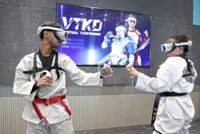Sometimes I want to rip off the headset and return to my unfocused reality. But I stick with it, and this virtual world starts to feel like an extended hand. — Photo by Dingzeyu Li on Unsplash
"You should try meditation." I heard this often during the worst of the pandemic, when vaccines weren't available yet, and I was frightened to open my apartment door. And I heard it when I was struggling through earlier bouts of stress or depression.
And for too long, I made a mistake. I wrote off such suggestions.





